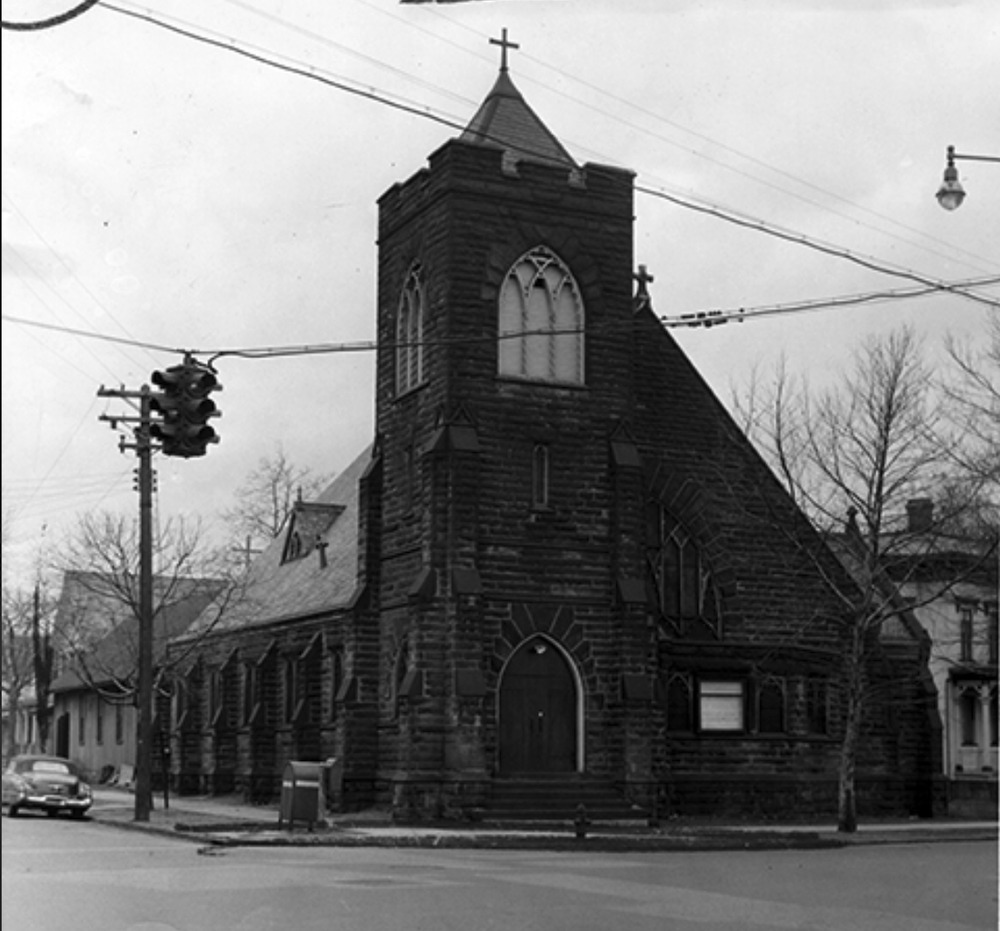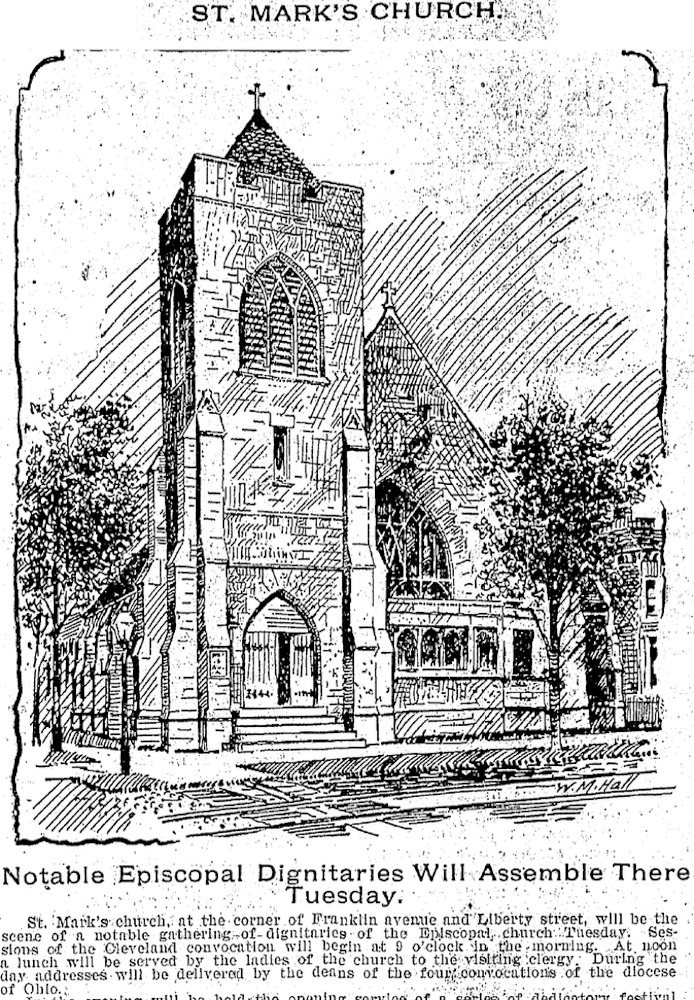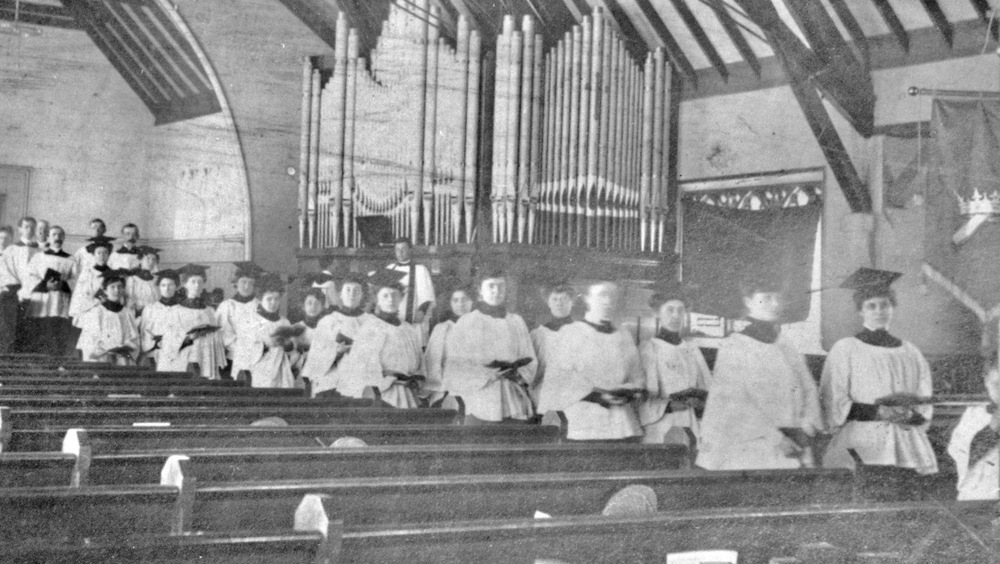Saint Mark's Episcopal Church
Built for a burgeoning 19th century West Side population

In May 1867, a reporter for the Plain Dealer trudged up 70 steps to the top of the Kentucky Street Reservoir on Franklin Avenue (Boulevard) near Kentucky (West 38th) Street. Perhaps after first stopping for a moment to catch his breath, he looked to the south and to the west at the houses he could see from that elevation. Judging the newness of houses by the appearance of their roofs and siding, he concluded that almost every other house within his field of vision was a new one, counting at least 75 of them, he wrote, before giving up. In this way, he was able to confirm one aspect of the incredible growth of Cleveland's west and south sides that had followed the end of the Civil War.
The Plain Dealer reporter wasn't the only person in Cleveland counting new houses on the city's west and south sides around this time. Reverend Lewis Burton, the long-time rector of historic St. John's Episcopal Church, was likely counting them too. By 1869, he had concluded that St. John's needed to expand and seed new Episcopal parishes on Cleveland's burgeoning west and south sides. How to do this, however, challenged him. St. John's had suffered a disastrous fire in April 1866 and its modest parish was still saddled with debt that had been incurred rebuilding after that fire. Burton solved the problem when, in January 1870, he formed a new parish group which he named the "Missionary and Church Extension Association of St. John's Parish" and asked them to help. He soon found that not only had the Association raised enough money to build chapels for the west and south side missions he desired, but it had also in the process reduced the parish's debt. He reported this serendipitous development at the Ohio Episcopal Diocese General Convention in June 1870.
Much of the housing growth which both the rector and the reporter had noted in the 1860s was in residential subdivisions to the north and south of Franklin Avenue, west of Taylor (West 45th) Street. Prominent west side developers Silas S. Stone, Jacob Perkins, George Benedict, and Elias Root had laid out large subdivisions in this area in the 1850s, around the time of Ohio City's annexation to the City of Cleveland. It was in the midst of these large subdivisions that St. John's Episcopal parish in the summer of 1870 sited its west side mission, building a small wooden chapel near the southwest corner of Franklin and Liberty (West 48th) Street. As soon as it was completed, Reverend Burton began holding weekly services in the chapel every Sunday. By 1872 so many were attending those services that a new Episcopalian parish was organized. Burton then resigned as rector of St. John's so that he could be elected the first rector of the new parish, which was named St. Mark's. At about the same time, he and his family moved from their house on Vestry Street, not far from St. John's, to a new house on the lot immediately to the west of where the chapel (now St. Mark's Episcopal church) stood. Burton served as rector of the new parish until his retirement in 1887. Thereafter, he served as rector emeritus until his death in 1894.
It was during the period 1890-1892, under the leadership of Burton's successor, the Reverend Francis Mason Hall, that St. Mark's parish built a new, larger church, the one which still stands on the southwest corner of Franklin Boulevard and West 48th Street and which is the subject of this story. Made of stone and featuring cathedral windows, the new church was erected just to the north of the original wooden church, which subsequently became a parish meeting hall. The new church was designed by architect H. B. Smith in the English Gothic style, according to an article appearing in the Plain Dealer on September 30, 1890. Perhaps its most significant architectural feature is its 62-foot-tall tower which looms over the corner of Franklin and West 48th. The church has more than 3000 square feet of internal space--almost three times that of the original wooden church--and it was reported to have a seating capacity when built of approximately 400. Church records, local histories, and newspaper articles, suggest that the new, larger church was needed by the parish to accommodate growth. According to available sources, in 1879 the parish had 151 communicants. By 1901, this number reportedly had nearly tripled to 425.
The stone church on the corner of Franklin and West 48th served the St. Mark's parish as a place of worship for nearly a half century before the parish moved out of it in 1940 and into a new church at 15305 Triskett Road in Cleveland's West Park neighborhood. A lack of primary or secondary sources makes it difficult to determine exactly why the parish moved in that year from its long-time Franklin Boulevard location. However, a review of Cleveland necrology records from the period 1870-1940 suggests that, by the third decade of the twentieth century, many of the church's parishioners had moved from the near west side to either the far west side or to west side suburbs of Cleveland, especially Lakewood. Thus, it is possible that the church moved west simply to be located in closer geographical proximity to a majority of its parishioners. In addition, the number of parishioners may have declined, rendering the church on Franklin Boulevard too large for a dwindling, distant parish population. St. Mark's new church on Triskett Road was smaller and had, according to newspaper accounts, seating for only 160 people.
After the departure of St. Mark's parish, the stone church on Franklin Boulevard stood vacant for a number of years. The original wooden church on the property, however, continued to serve a purpose within the Ohio Episcopal Diocese, becoming home to St. Agnes Episcopal Church for the Deaf from 1940 to 1953. In March 1953, according to an article appearing in the Plain Dealer on July 4th of that year, the Episcopal Diocese of Ohio sold the former St. Mark's church property to the First United Pentecostal Church. The article noted that the new congregation had been in the process of renovating and remodeling the stone church when it was damaged during the historic June 8, 1953 tornado which caused extensive damage to many buildings on the west side of Cleveland. It is not clear from the article whether the damage to the church included its tower and/or whether the 1953 renovation of the church included covering much of the tower with the red siding emblazoned with a large cross still seen on it today. The covering of the tower, however, was done by the Pentecostal Church at some point in time before the summer of 1970, when sketches of the church in ads appearing in the Plain Dealer clearly showed the tower already covered.
During the last three decades of the twentieth century, the former St. Mark's Episcopal church at the corner of Franklin and West 48th was home to several other Christian denominations, including the Foursquare Gospel Church (1972-1981), Calvary Christian Center (1986-1992), and God is Love (1992-1995). In 1995, it became home to a Hispanic Evangelical congregation known as Iglesia del Salvador, which it remains to this day.
Images












